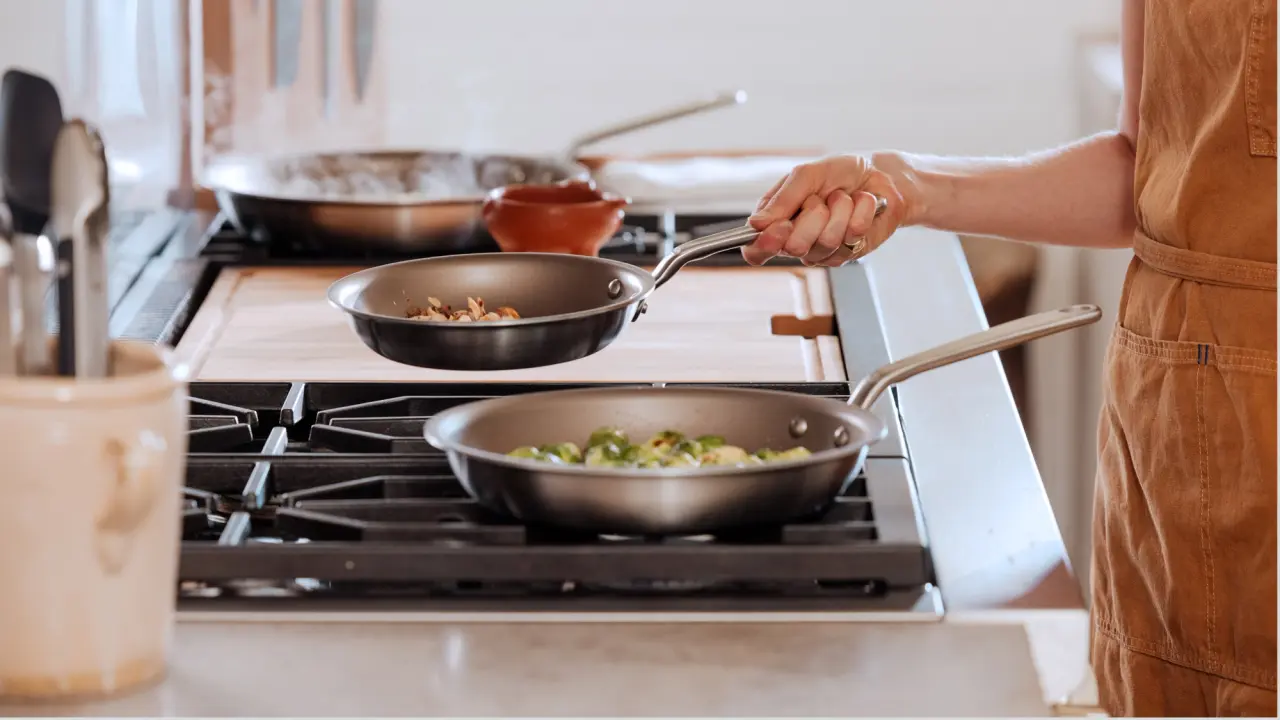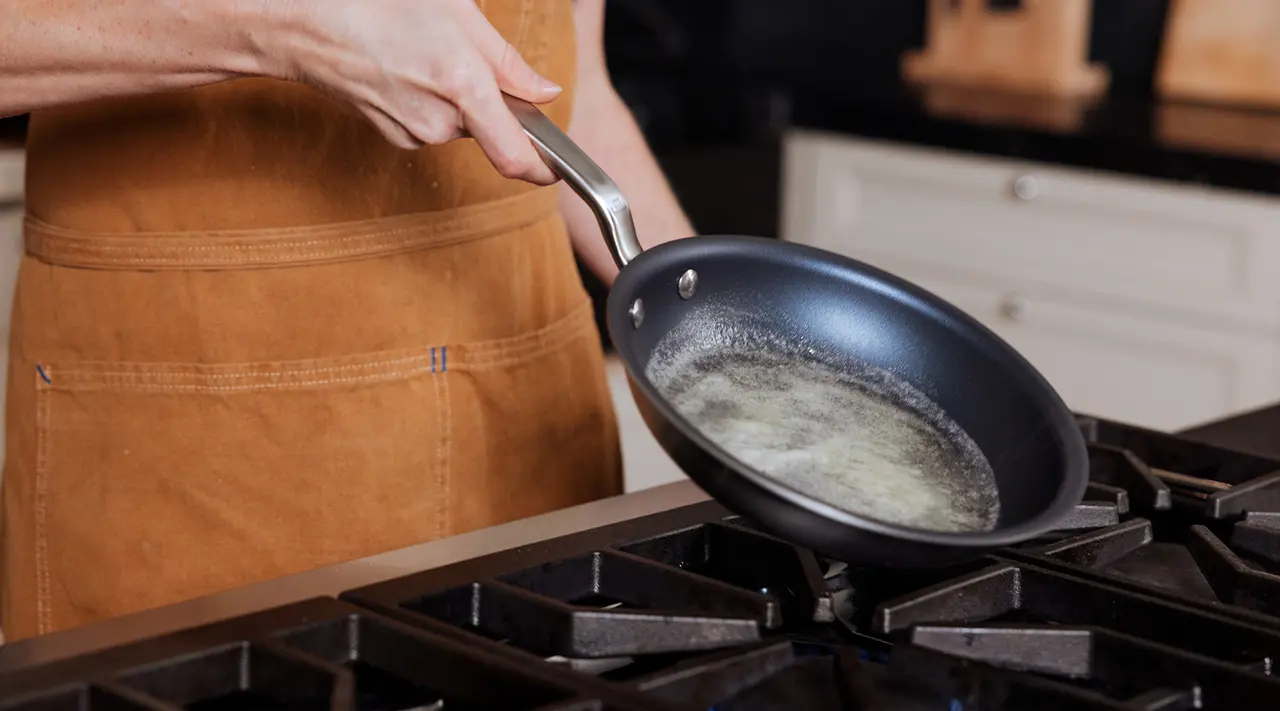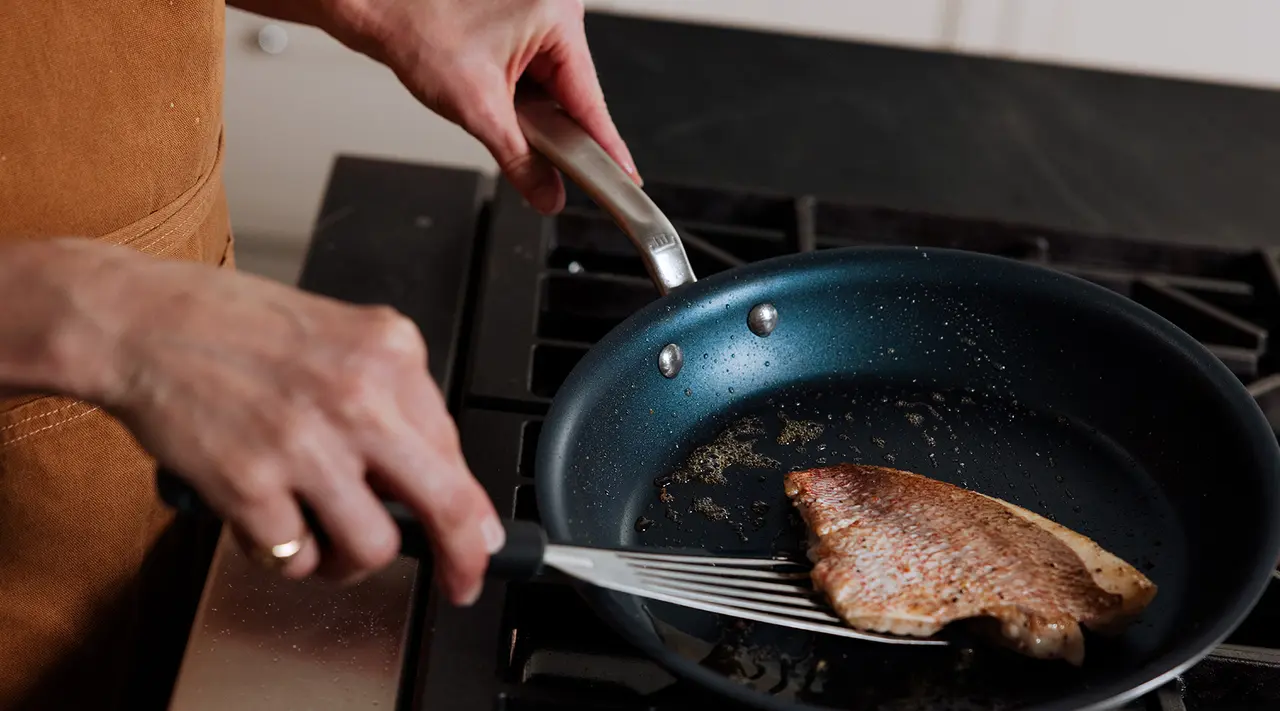While stainless steel, cast iron, and carbon steel all have their place, non stick cookware deserves a spot in your kitchen, too. It provides peace of mind and practically guarantees delicate ingredients won’t stick and burn.
Of course, when it comes to non stick cookware, you get what you pay for. Lower quality doesn’t last as long, meaning you’ll have to replace it more often. When choosing high quality non stick cookware, like ours, you’re getting a long-lasting pan with the even heating properties of our Stainless Clad paired with an easy-to-clean, professional-grade non stick surface. Here’s what you need to know about cooking with—and understanding—non stick pans.
Understanding Non Stick

Our Non Stick Cookware starts out as our Award-Winning 5-Ply Stainless Clad Cookware. We then add two layers of durable, FDA-approved non stick coating to ensure each piece in our Non Stick Collection heats evenly while providing a frictionless cooking surface, ideal for all manner of dishes (but especially delicate things like eggs and fish).
We also attach our hollow Stay Cool Handle™, so you can maneuver the pan with confidence. Non stick pans are also the best for heating up leftovers—yes, even better than a microwave—from recrisping a chicken cutlet to reviving a portion of pasta. And since food doesn’t stick, cleanup truly is a breeze.
While you can achieve a non stick surface with other types of material, our Non Stick Collection stands apart for a few reasons—a big one being its ability to handle any ingredient. Carbon steel, provided you maintain and season it well, can eventually boast a non stick surface, but that surface does not do well with acidic ingredients like tomatoes or vinegar. To round out your cooking options and provide extra versatility, we recommend having at least one non stick pan in your cabinet.
Tips for Using Non Stick Pans

If you’ve never used non stick before, congrats—you picked a pan with little to no learning curve. Here are a few things to keep in mind while cooking with non stick to preserve the coating, but it really is as simple as turning your burner on.
Practice Temperature Control
Our non stick pans are oven safe up to 500F, so you can start something on the stove—a frittata, for example—and finish it in the oven. But when cooking on the stovetop, it's best to avoid high heat to help maintain the non stick coating.
Since our pans feature a 5-ply Stainless Clad body, they heat quickly and evenly so there’s no need to start them over high heat, even if you’re in a hurry or trying to sear a protein. We recommend sticking to medium to low temperatures when using our non stick pans—more on that below.
Be Gentle
A light touch will help preserve the coating of non stick too, meaning t’s best to avoid abrasive utensils. Instead, reach for a wood or silicone spoon or spatula, rather than metal. No matter which type of tool you use, also avoid scraping the bottom of the pan too aggressively. If your recipe calls for deglazing—scraping up bits of stuck-on food with a liquid—or whisking to avoid sticking, it’s best to use a more durable carbon steel, stainless steel, or cast iron pot or pan.
We also recommend washing by hand, with a soft sponge or dishcloth. Thankfully, the non stick surface means cleaning up is easy, and our non stick care guide is ready to assist if that’s not the case.
Avoid the Dishwasher
We generally advise to avoid the dishwasher when cleaning all of our pans, even if they technically can be washed in the machine. This is especially true with our non stick cookware; although they feature premium construction, the non stick coating can be seriously damaged within the harsh environment of a dishwasher—even one trip through the dishwasher can result in a pan with a peeling surface.
Instead, use a dish sponge or dishcloth to wash your pan with warm, soapy water. If you’re dealing with burnt residue, try a mix of water, baking soda and vinegar. Check out our guide to cleaning non stick cookware for more detailed instructions.
Common Mistakes to Avoid

With proper maintenance and care, your non stick pans will last for years. Here are a few things to avoid to keep those pans in tip top shape.
Overheating the Pan
Repeated exposure to high heat will wear down the non stick coating faster, simple as that. Instead, use your non stick pan over low to medium heat. If your dish requires you to crank the heat up, we recommend using a carbon steel or stainless steel pan, depending on the dish. Both materials can handle high temperatures without damage.
Preheating While Empty
With certain materials, like stainless steel, it’s best to preheat the pan before adding oil. When using non stick cookware, always preheat the pan with oil or another fat in it, or the non stick coating can be damaged. We advise skipping cooking spray, as it will burn a residue onto the pan. And, adding fat to the cold pan before heating strengthens the non stick properties of the pan.
Using Metal Utensils
Remember those layers of non stick coating? They can be damaged if scraped with certain utensils, especially metal. Instead, use wood or silicone, which are much less likely to scrape up the delicate coating.
Stacking Improperly
Likewise, nesting pans inside one another can lead to unintentional scraping. We recommend hanging your non stick pans or, if you prefer to stack them on a shelf or in a drawer, do so with a layer of kitchen towels or non-metal trivet in between for added protection.
Advantages of Non Stick Cooking

If you’re trying to use less fat when cooking, then non stick cookware is a great option. Although you do need some fat when cooking with non stick (remember the pre-heating advice above), a little goes a long way thanks to the pan’s coating. Our Non Stick Collection also makes it easier to cook delicate foods (or foods that are prone to sticking) like filets of fish, eggs, and pancakes.
Additional Longevity and Care Tips
Our Non Stick Cookware collection provides low-maintenance convenience, but it still requires some care to get the most out of its lifespan. In addition to storing properly, as described above, you should regularly inspect the surface for signs of wear and tear. After enough use, all non stick pans will eventually need to be replaced. A few small scratches or a little discoloration shouldn’t cause alarm, but a peeling coating should give you pause. Ditto severe discoloration and lots of scratches.
Another tell-tale sign that you need a new pan is when food starts sticking to the pan. If it’s just a few trouble spots, then you can follow these steps to try restoring the pan’s non stick surface. If that doesn’t work, or if more food is sticking to your pan than isn’t, then it’s time to replace it.
Ready to Shop?
Keeping a non stick pan in your kitchen cabinets provides even more versatility when cooking. With proper cleaning, care and maintenance, you’ll easily learn how to use non stick pans to cook up all manner of dishes. Browse our Non Stick Collection to find the right pan or set for you.































